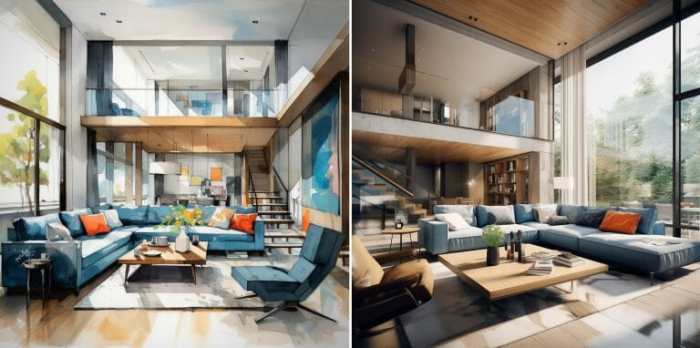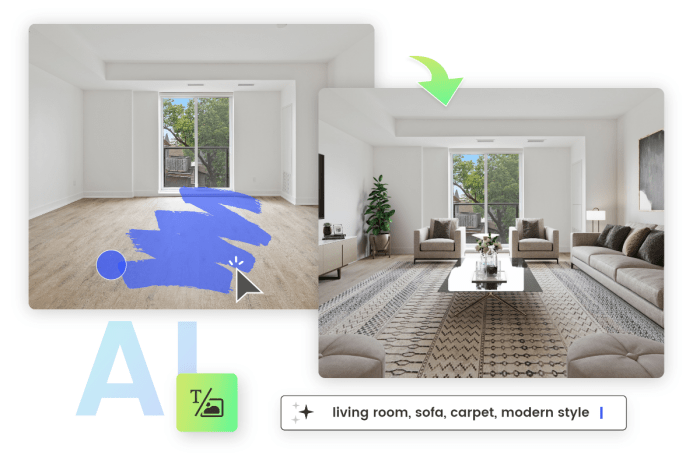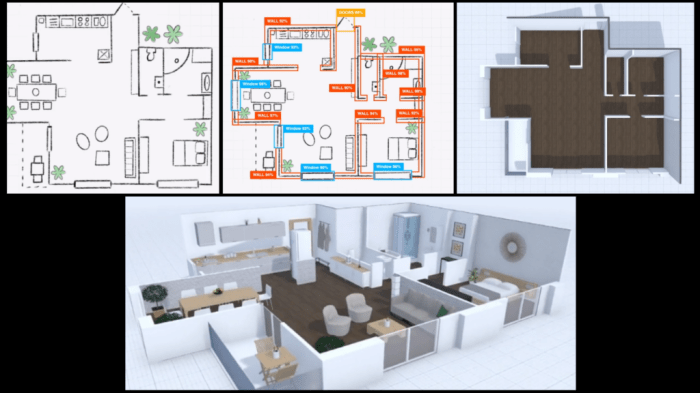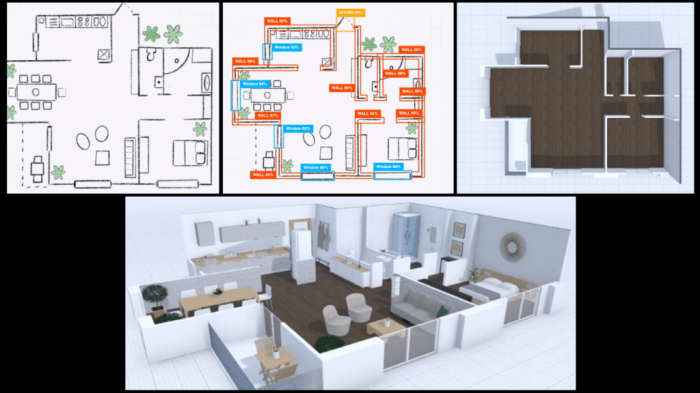AI Design: Transforming House Interiors
Ai design house interior – AI Design: Transforming House Interiors takes center stage, ushering in a new era of personalized and intelligent home design. The integration of artificial intelligence is revolutionizing traditional interior design processes, empowering both designers and homeowners with powerful tools and insights.
From generating personalized color palettes and furniture recommendations to optimizing space utilization and creating stunning 3D visualizations, AI is rapidly reshaping the way we approach interior design.
This shift towards AI-driven design is driven by a desire for personalized experiences and efficiency. AI algorithms can analyze vast amounts of data, including user preferences, design trends, and spatial constraints, to create tailored design solutions that cater to individual needs and tastes.
As AI continues to evolve, we can expect even more innovative applications in the field of interior design, blurring the lines between technology and creativity.
AI for Furniture and Decor Recommendations

AI is revolutionizing the way we design and furnish our homes. By leveraging machine learning algorithms and vast datasets, AI can analyze user preferences and offer personalized furniture and decor recommendations, transforming the interior design process.
AI-Powered Furniture and Decor Recommendations
AI can analyze a user’s preferences and style based on various data points, including:
- Visual Preferences:AI can analyze images of furniture and decor that a user likes, identifying patterns in style, color palettes, and design elements. This could include browsing history on websites, images saved on social media, or even photos of their current living space.
- Lifestyle and Needs:AI can consider the user’s lifestyle, including factors like family size, hobbies, and daily routines. For example, a family with young children might require durable and kid-friendly furniture, while a single professional might prioritize a minimalist and functional space.
- Budget and Space Constraints:AI can take into account the user’s budget and the size and layout of their space to suggest furniture and decor that fits their needs and limitations. This helps users make informed decisions without exceeding their budget or compromising on style.
Based on this data, AI can generate personalized recommendations for furniture and decor items that align with the user’s taste and requirements.
A Hypothetical Scenario: AI-Powered Living Room Design, Ai design house interior
Imagine a young couple starting their first home. They have a modern aesthetic and prefer neutral colors with pops of bright accents. They are looking to furnish their living room, which is relatively small.An AI-powered design assistant could analyze their preferences and provide tailored recommendations.
For example, it might suggest:
- A modular sofa in a light gray fabric with removable cushions, allowing for flexible seating arrangements and easy cleaning.
- A sleek coffee table with a glass top and a metal frame, maximizing space and adding a touch of industrial chic.
- Wall-mounted shelves with vibrant artwork to break up the neutral color scheme and showcase their personal style.
- A large area rug in a geometric pattern to define the living room space and add warmth and texture.
The AI could even offer different options for each item, allowing the couple to choose the specific pieces that best suit their needs and preferences.
Comparing AI-Driven Recommendations with Traditional Design Consultation
AI-powered design recommendations offer several advantages over traditional design consultations:
- Accessibility and Affordability:AI-driven tools are often more accessible and affordable than hiring a professional interior designer. This makes personalized design services available to a wider audience.
- Convenience and Efficiency:AI can analyze data and provide recommendations quickly and efficiently, allowing users to explore various options and make decisions at their own pace. This eliminates the need for scheduling appointments and waiting for consultations.
- Objectivity and Data-Driven Insights:AI recommendations are based on data and algorithms, reducing the potential for subjective biases that can occur in traditional design consultations.
However, traditional design consultations still offer some advantages:
- Personalized Attention and Expert Advice:A professional designer can provide personalized attention and offer expert advice based on their experience and understanding of design principles. They can also offer solutions to unique challenges and provide insights that AI may not be able to capture.
- Creative Vision and Conceptualization:Designers can create a cohesive vision for a space, taking into account the user’s needs and aspirations. They can also conceptualize innovative solutions and suggest unique pieces that might not be readily available through AI-powered tools.
Ultimately, the best approach to interior design depends on the individual’s needs and preferences. AI-powered tools offer a convenient and affordable option for personalized recommendations, while traditional design consultations provide personalized attention and expert guidance.
AI-Powered Lighting Design

AI is revolutionizing interior design, and lighting is no exception. By leveraging AI algorithms, designers can create lighting schemes that are both functional and aesthetically pleasing. AI-powered lighting design goes beyond simply illuminating a space; it optimizes the lighting experience for each user and purpose.
AI-powered design tools can be a boon for creating efficient and stylish interiors, especially in smaller spaces. If you’re working with a 30 square meter home, maximizing functionality is key, and AI can help you visualize different layouts and furniture arrangements.
Check out this article on 30 square meter house interior design for inspiration, then let AI help you bring your vision to life.
AI Optimization for Lighting Schemes
AI-powered lighting design involves analyzing various factors to create the ideal lighting environment. These factors include the room’s purpose, size, and shape, as well as the desired ambiance and user preferences. AI algorithms can analyze these factors and suggest optimal lighting solutions that enhance functionality and aesthetics.
For example, AI can determine the best placement and type of light fixtures to create a comfortable and inviting atmosphere in a living room, or it can optimize the lighting in a kitchen for tasks like cooking and food preparation.
AI-Powered Lighting Design Solutions
AI-powered lighting design solutions offer a range of benefits, including:
- Personalized Lighting Experiences:AI can learn individual preferences and adjust lighting settings accordingly. For instance, AI can dim the lights in the evening to create a relaxing atmosphere or brighten them during the day for optimal task lighting.
- Energy Efficiency:AI algorithms can optimize lighting schedules and adjust brightness levels to minimize energy consumption. By automatically adjusting lighting based on occupancy and time of day, AI can significantly reduce energy waste.
- Enhanced Ambiance:AI can create dynamic lighting effects that change throughout the day or in response to user input. This allows for the creation of different moods and atmospheres, enhancing the overall ambiance of a space.
- Improved Safety and Security:AI-powered lighting can automatically adjust brightness levels based on external factors such as weather or time of day, improving visibility and enhancing safety.
Example of an AI-Generated Lighting Plan
Imagine a modern living room with a large open floor plan. An AI-powered lighting design tool can analyze the room’s dimensions, furniture layout, and window placement to suggest a lighting scheme that maximizes functionality and aesthetics. The AI might recommend a combination of ambient lighting, task lighting, and accent lighting.
For example, the AI could suggest installing recessed downlights throughout the ceiling to provide general ambient lighting. In addition, a stylish floor lamp could be placed near the sofa, providing task lighting for reading or working. Finally, accent lighting could be used to highlight specific architectural features or artwork, adding visual interest and depth to the space.The AI-generated lighting plan would also consider factors such as natural light levels and the desired mood.
The AI might suggest using warm white light in the evening to create a cozy and inviting atmosphere, while cooler white light could be used during the day to enhance focus and productivity.
AI design can help you visualize your dream home, even if you’re aiming for a specific era. If you’re drawn to the groovy vibes of the 70s, AI can help you recreate that retro feel. You can explore the key elements of 70s house interior design and let AI generate different layouts, color palettes, and furniture arrangements that capture that unique style.
From there, you can refine your vision and create a truly personalized space that reflects your love for the 70s while still incorporating modern comforts and conveniences.
The Future of AI in Interior Design: Ai Design House Interior

The world of interior design is undergoing a significant transformation, driven by the rapid advancements in artificial intelligence (AI). AI is poised to revolutionize the way we design, plan, and experience our living spaces. From personalized recommendations to intelligent automation, AI is set to reshape the industry in ways we are only beginning to imagine.
AI-powered design tools are revolutionizing the way we approach interior design, offering personalized recommendations and efficient layouts. While AI can analyze trends and suggest modern solutions, understanding the historical context of interior design is crucial. For example, exploring the elegance and craftsmanship of 1900 house interior design can provide inspiration for incorporating timeless elements into modern spaces.
By combining AI’s efficiency with the timeless beauty of historical design, we can create truly unique and captivating interiors.
The Potential Impact of AI on the Role of Human Designers
The integration of AI in interior design raises important questions about the future role of human designers. While AI can handle many tasks efficiently, it is crucial to understand that AI is a tool, not a replacement. AI can empower designers to focus on their creative strengths, such as conceptualization, artistic vision, and client communication.
- AI can automate repetitive tasks, such as generating floor plans, selecting furniture, and creating mood boards, freeing up designers to focus on more strategic and creative aspects of the design process.
- AI can analyze vast amounts of data to identify trends, predict user preferences, and provide personalized design recommendations, enhancing the design process and ensuring that the final product aligns with the client’s needs and desires.
- AI can also assist in the development of innovative design solutions by exploring new materials, textures, and forms, pushing the boundaries of creativity and pushing the limits of design possibilities.
Final Conclusion
The future of interior design is undeniably intertwined with AI. As AI technology continues to advance, we can anticipate a future where personalized and intelligent design solutions become the norm. From automated design workflows to immersive virtual reality experiences, AI will play a crucial role in shaping the homes of tomorrow.
While ethical considerations and the potential impact on human designers remain important topics for discussion, the integration of AI in interior design offers a promising path towards creating more beautiful, functional, and sustainable living spaces.
Common Queries
What are some popular AI-powered interior design tools?
Popular AI-powered interior design tools include Roomstyler, HomeByMe, and Houzz.
Can AI design an entire house?
While AI can assist in various aspects of home design, it is not yet capable of designing an entire house independently. Human designers are still essential for creative vision, artistic expression, and client communication.
How can I use AI to personalize my home design?
You can use AI-powered tools to upload photos of your space, specify your style preferences, and receive personalized recommendations for furniture, decor, color palettes, and layouts.

